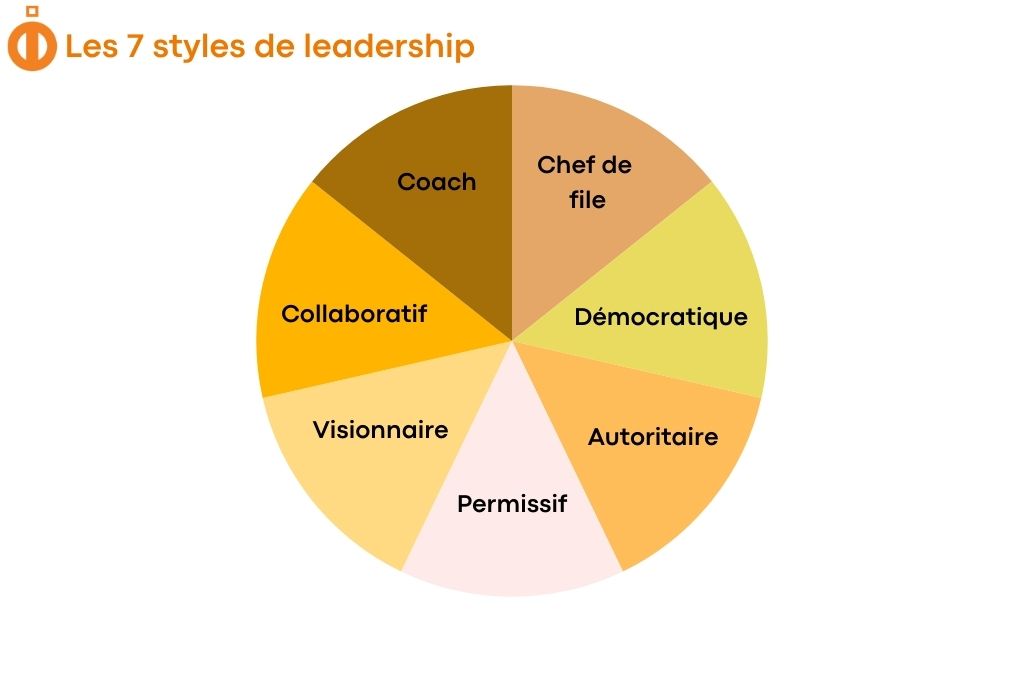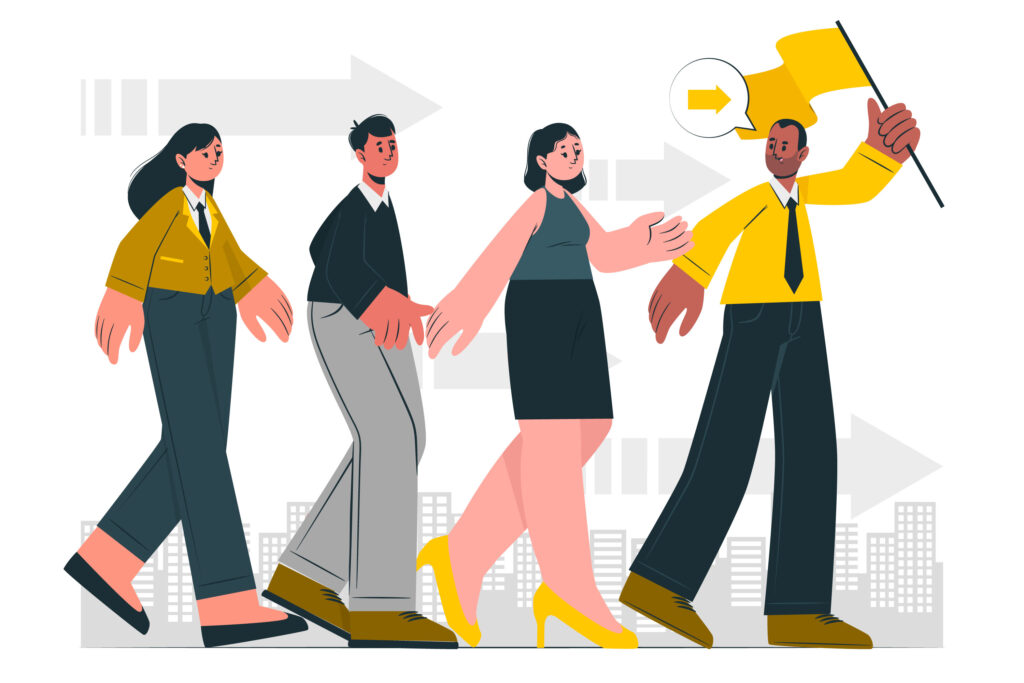Leadership in business, whether authoritarian, democratic or visionary, is the ability to influence, guide and motivate a team towards a common goal, guide and motivate a team towards a common goal. However, leadership is not simply about being a manager, but rather about the ability to lead, take the initiative, inspire and instil confidence in all members ofa team.
You want to be a good leader, to mobilise your teams and the various human resources around common objectives to improve your company ‘s performance? Intuition Software explains all about the different leadership styles, their advantages, and how to choose the most effective type of leadership for your needs and professional context.

Leadership styles in a nutshell
- Leadership is an individual’ sability to mobilise and direct teams towards a specific goal.
- Leadership encompasses several approaches, grouped into two main leadership models: traditional and modern.
- Traditional leadership models include authoritarian, democratic and permissive leadership.
- Modern leadership models include visionary leadership, collaborative leadership and coaching leadership.
- There is no single model of leadership: a good leader must know how to adapt his or her leadership style to the needs of his or her team, the company’ s challenges and the context.
What is leadership?
Leadership defines the ability of an individual in a position of authority to mobilize other individuals in a group towards a defined objective. A leader is therefore someone who knows how to inspire, direct and unite his or her team so that they work together towards a common goal.
In business, leadership is based on several key elements:
- Communication,
- Vision,
- Confidence,
- The ability to make informed decisions.
A good leader knows how to identify the strengths of each individual and use them in the best possible way, to ensure effective teamwork.
Leadership is also a question of adaptability, a leader needs to know how to adjust his or her approach to the challenges and group dynamics. Unlike management , which focuses more on organisation and planning, leadershipis based on inspiration and influence. In the professional world, this ability to motivate and guide is a major asset for any company.
What is the difference between leadership and management?
Leadership is a quality, the ability to inspire and motivate a team through a shared vision, while management is operational, which involves organising work, planning, managing resources and ensuring that everything runs smoothly on a day-to-day basis within the company. So, while every manager must be a good leader, not every leader is necessarily a good manager.
As a result, while the manager follows precise rules and a clear hierarchy to ensure that everything runs smoothly, the leader , has a broader role, influencing and motivating employees to give their best and move in the same direction.
The ideal way to manage your teams and improve performance is to combine management and leadership, In other words, to be a good manager who inspires his or her team to encourage innovation and commitment.

What are the different styles of corporate leadership?
There are two main models of business leadership:
- Traditional leadership, which is still the structure of many professional structures,
- Modern leadership, with more emphasis on innovation and people.
What are the different types of traditional leadership?
According to the American psychologist Kurt Lewin, there are three main styles of leadership:
- Authoritarian leadership,
- Democratic leadership,
- Permissive leadership.
These models, often referred to as”traditional”, were defined in the 1930s, and served as the basis for management methods for many decades. Today, even though certain management methods are evolving towards greater flexibility, these types of management are still widely used, depending context and the specific needs of a company.
Authoritarian leadership style
Authoritarian, or autocratic, leadership is based on a centralized model in which the leader holds all decision-making power. A single person, the leader, makes the decisions and imposes a strict framework on his or her team, without necessarily seeking the opinion of employees.
This style of leadership originated in the military and industrial structures of the early 20th century, where speed ofexecution and discipline were essential to achieve results and objectives. With this type of leader , centralised decision-making helps to meet tight deadlines, avoid confusion and ensure that actions are carried out quickly.
The benefits of authoritarian leadership
- Increased efficiency in environments requiring rapid decisions.
- Reduce ambiguity with clear guidelines.
- Ideal for crisis situations requiring rigorous management.
The disadvantages of authoritarian leadership
- Lack of team flexibility and creativity.
- Risk of demotivating employees due to lack of autonomy.
- The working environment can be tense and stressful.

The democratic (or participative ) leadership style
Democratic leadership, or participative leadership , is based on participative management , where the leader actively involves his or her team in decision-making. Rather than imposing their choices, they encourage the exchange of ideas, listens to suggestions and seeks to build a shared vision with his colleagues.
This approach is in line with participative management, which aims to encourage employee autonomy and empowerment by fully integrating them fully into the processes of reflection and action. Democratic leadership allows employees to feel valued and committed, which often boosts their motivation, creativity and well-being at work.
Benefits of participative leadership
- Increased employee involvement through participation in decision-making.
- Increasing creativity and developing a culture of innovation and collaboration.
- Improving team motivation and satisfaction.
- Reduced risk of brown-out, silent resignation, and team turnover.
Disadvantages of participative leadership
- Slower decision-making due to numerous consultations.
- Can lead to conflict when opinions differ widely.
- Ineffective in situations where quick decisions are required.
In contexts requiring immediate reactivity, such as in times of crisis, this type of leadership may be less appropriate. Nevertheless, democraticleadership remains one of the most effective models for creating a positive and dynamic corporate culture, where every employee feels involved in the success of the organisation.

Permissive leadership style
Permissive leadership, also known as “laissez-faire”, is a leadership style that gives employeesa great deal of autonomy. In this model, employees are considered to be sufficiently competent and motivated and motivated to manage their work independently, without the need for constantsupervision.
This leadership model is particularly appreciated in environments where independence and creativity are essential, such as start-ups , design agencies or technology companies. It allows teams to express themselves freely, innovate and take the initiative, without being held back by an overly rigid hierarchy.
Benefits of permissive leadership
- Ideal for experienced, autonomous teams.
- Encourages creativity and employee empowerment.
- Reduces the stress associated with excessive supervision.
Disadvantages of permissive leadership
- Can lead to a lack of clear direction and a drop in productivity.
- Risk of employees becoming isolated without regular feedback.
- Less suitable for teams needing a structuring framework.
To avoid the problems associated with this style of leadership a permissive leader needs to strike a balance between autonomy and support. It ‘ s not about leaving your team to fend for themselves, but to ensure that each member of staff has the resources, tools and information to do their job properly. Even if supervision is minimal, it is important to establish a clear framework by defining precise objectives and clearly formulated expectations.
What are the different types of modern leadership?
The American psychologist Daniel Goleman has identified different leadership styles, based on emotional intelligence, which place people at the heart of management. There are 4 main ones:
- Visionary leadership,
- Collaborative leadership,
- Leadership coaching,
- Leading from the front.
A 2023 study conducted by the EDHEC NewGen Talent Centre in collaboration with G16 Careers among more than 2,000 young graduates reveals that expectations of managers have changed. 73% of young professionals prefer a manager who is transparent and honest, and 67% prefer a leader who trusts and encourages autonomy. This trend illustrates a growing need for management based on trust, listening to employees and involving them in strategic decisions.
The new types of leader identified by Daniel Goleman encourage innovation, collaboration and adaptability, so that teams evolve in a more dynamic and stimulating environment. These approaches encourage not only performance, but also professional fulfilment , which is central.

Visionary leadership style
Visionary leadership is based on the leader ‘sability to anticipate the future and inspire his or her team with a clear and ambitious vision. The visionary leader defines a long-term strategic direction and motivates by showing them how their efforts fit into an overall project.
This type of management has developed as companies have understood the importance of giving meaning to their actions and involving their their employees arounda common project where it is essential to have a clear direction to guide the teams.
Benefits of visionary leadership
- Stimulates creativity and innovation.
- Inspires strong motivation within teams.
- Fosters a corporate culture focused on growth and progress.
Disadvantages of visionary leadership
- May lack pragmatism in day-to-day management.
- Requires autonomous and proactive employees.
- Requires excellent internal communication to align the whole team with the vision.
Visionary leadership is therefore a powerful lever for transforming an organisation, But to be fully effective, it mustbe accompanied by effective management and good communication.
The collaborative leadership style
Collaborative leadership is based on the idea that an organisation ‘s performance depends above all on the collective intelligence and involvement of its teams. The collaborative leader therefore acts assomeone who seeks to create an environment where everyone can express themselves and contribute to the strategic direction.
Communication is at the heart of this approach: exchanges are encouraged, feedback is frequent and decisions are taken collectively. This type of leadership favours horizontal management, with less hierarchy and more shared responsibility. The aim is to enable each member of staff to feel that they have a part to play in the project.
Benefits of collaborative leadership
- Reinforces cohesion and team spirit.
- Encourages employee commitment.
- Encourages a diversity of ideas and innovative solutions.
Disadvantages of collaborative leadership
- Can slow down decision-making when opinions differ.
- Requires active management of conflicting ideas.
- It requires a well-defined organisational framework to remain effective.
- The emotional boundary between the leader and the team must be balanced.

Leadership coaching style
Leadership coaching focuses on the personal and professionaldevelopment of employees. It aims to support team members in their progress and personal development.
The leader coach adopts a guiding rather thana supervisory stance. Rather than giving orders or setting strict guidelines , it favours constructive exchanges, regular feedback and encouraging people to take the initiative. This leadership style encourages employees to develop new skills, to take on challenges and move out of their comfort zone. Learning is seen as a lever for development rather than a constraint.
Benefits of leadership coaching
- Improves talent satisfaction and retention.
- Develops individual and collective skills.
- Creates a culture of learning and continuous improvement.
Disadvantages of leadership coaching
- Can be time-consuming for the leader , who has to invest personally in every member of the team.
- Requires a high level of personal commitment on the part of the leader and staff.
- Requires a balance between support and autonomy.

Leading from the front.
Leadership as a leader, also known as exemplary leadership , is based on the idea that the leader should be a role model for his or her team. It is the leader who sets the example. The leader is often very demanding of himself and expects the same rigour from his team.and expects the same rigour from his team.
The leader sets ambitious targets and pushes his or her team to exceed their limits. This management style is based on a strong culture of merit: Efforts and results are rewarded, and top performers are valued.
Benefits of leadership
- Increased productivity by encouraging the team to give its best.
- Accelerated learning: Employees evolve rapidly by learning directly from the leader and adopting his or her best practices.
- A culture of excellence and a focus on performance.
- Motivation by example.
Disadvantages of leadership
- High pressure and high expectations of the leader , which can lead to stress.
- Internal competition due to focus on individual performance .
- De-motivation of under-performers.

How do you choose the right leadership style to be an effective leader?
The choice of leadership style depends on many factors: the culture of the company, the composition of the teams, the objectives to be achieved and the personality of the leader. There is no single model that works in all circumstances. However, a good leader generally knows how to analyse their environment and adapt their approach to meet the needs of their team and the challenges of their organisation.
- Assessing your team and your environment: before choosing a leadership style, the leader needs to analyse the maturity of the team, its level of autonomy and its expectations. For example, a team with a great deal of experience will function better under collaborative or coaching leadership, whereasa more junior team or one that needsa structured structured framework will benefit morefrom more directive leadership.
- Adopt flexible leadership: effective leadership does not mean being locked into a single leadership style. A good leader must know how to adapt and alternate between different approaches depending on the situation. For example, visionary leadership can be combined with a collaborative approach, to involve teams, while maintaining a clear strategic direction.
- Adapting to thecompany’ s challenges: Each phase of a company ‘s development requires a different leadership style. During a period of strong growth, visionary leadership can be key to aligning teams around an ambitious vision. In times of crisis, on the other hand, authoritarian, more structuring leadership may be necessary to ensure stability.
To be an effective leader, , is above all to be able to observe, listen and adapt to the needs of your team and the challenges it faces, listen and adapt to the needs and challenges of your team. Whatever the leadership style adopted, the ultimate objective remains the same: to ensure collective success by aligning everyone ‘s efforts towards a common goal.








